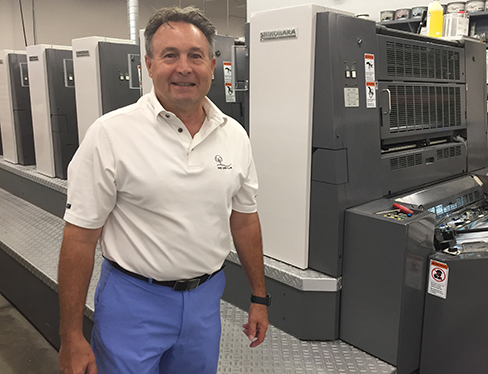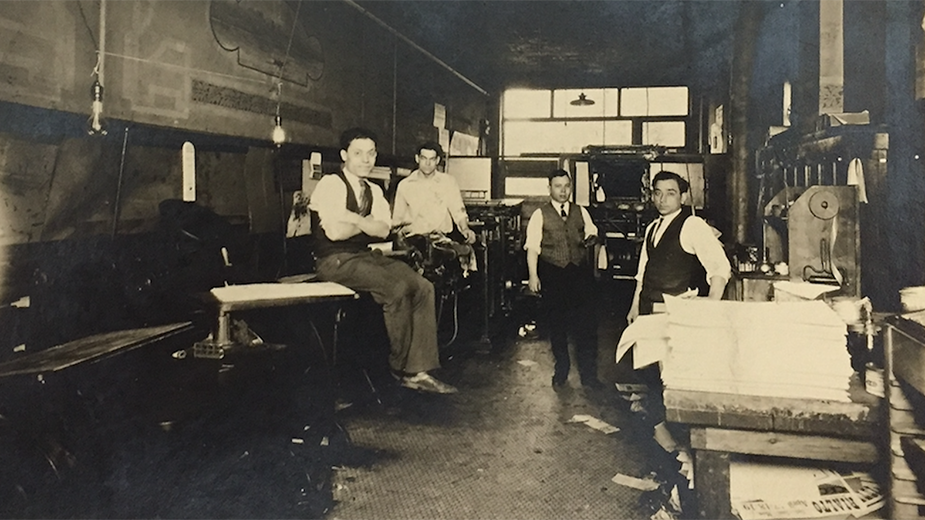YOUNGSTOWN, Ohio – Were it 103 years ago, the now gravel parking lot next to the Ohio One Building on South Champion Street in downtown Youngstown would have been teeming with activity.
Then, the site served as the location for a nondescript brick building that became the first home of City Printing Co., a business established by an enterprising immigrant from Bari, Italy, in 1920.
Joseph Valentini, born in 1889, lost his father at a young age. His mother, driven by a desire to see Joseph educated, arranged for him to attend school in Rome, where her brother had been installed as a priest.
“When he was 15, he was in school at The Vatican,” says Joe Valentini, Joseph’s grandson and today the president of City Printing. “That’s where he learned to read and write.”
Despite his grandfather’s devotion to the Catholic Church, there was no call to join the priesthood, Valentini says. Instead, in 1911, Joseph opted to board a passenger ship bound for America and was likely processed through the immigration center at Ellis Island in New York City.

It wasn’t long afterward that Valentini’s grandfather found himself in Youngstown, his grandson says. “He became involved in some sort of publishing because he could read and write,” in both English and Italian. By 1920, Joseph had saved enough to start a printing company of his own and settled into the building at 114 S. Champion St., where the business remained until 1970.
“He’s how we all got into the business,” Valentini says.
A photograph – probably dated sometime in the late 1920s or early 1930s – shows Valentini’s grandfather and three other employees positioned around what were at that time the tools of the trade of the industry. A linotype machine is visible in the background, while employees pose around composition desks and other equipment. Stacks of paper command the foreground of the photo, while the tiled floor is covered with splotches of printers ink. A closer look at the right hand corner of the picture reveals a print job advertising “Rialto” – an Italian word for “marketplace” or theater district, named for a central business and trading hub in Venice.
“He and my grandmother worked there for years,” Valentini says. Eventually, their two sons, Ralph and William – the latter Valentini’s father – joined the business and took over operations after his grandfather’s death in 1965. In 1970, in the midst of urban renewal reforms across downtown, City Printing relocated to Wood Street, where it stood until 2009.
“Back then, we did all the basic print jobs for everyone in the downtown area. Business cards, letterheads, envelopes, invoices – along with the publication of newsletters and brochures,” he says. For a time, until 1970, the company also printed the Daily Legal News, he says.
“I worked in the shop during high school in the late 1970s and went to YSU,” Valentini recalls.
RAPID CHANGES TO INDUSTRY, VALLEY
When he first entered the business, Valentini said the city and the Mahoning Valley were home to dozens of printing companies, both large and small. Youngstown Printing, to be renamed Youngstown Lithographing Co., was a large operation on Wick Avenue before it relocated to Austintown. Others included Royal Printing and St. Regis Printing. In nearby Warren, Superior Printing and Cox Printing were among the largest in the Mahoning Valley, if not northeastern Ohio. All are out of business today.
By that time, the industry – and the Valley – were changing rapidly. The demise of the region’s steel industry, followed by the closure of other major employers during the 1970s and 1980s, instigated a population bleed that continues today. That in turn affected the growth of small businesses.
“We have less people, less industry,” he says. “A lot of businesses have either been bought out, merged or closed.”
This trend, coupled with changes in the industry, has brought serious challenges for local printers. “There’s a ton of printing going on; there always will be,” Valentini says. “But it’s changed.”
The rise of the internet, along with self-printing and self-publishing serv-ices, has chipped into business for commercial print shops.
Moreover, the number of distributors in the area that once sold paper stock of all varieties in large volumes has also diminished, leaving companies such as City Printing to adapt and stay resilient.
“Before, if I wanted gray linen paper stock, I could pick up the phone and call and get it the next day,” he says. “There were five different merchants that represented two or three companies that made linen paper. I could call any one of them.”
Today – especially in the wake of supply disruptions caused by the pandemic – it’s harder to source specialty paper feedstock, Valentini says.
New Building, TechnologY
In 2009, Youngstown State University bought the building on Wood Street as part of its overall plan to build its new Williamson College of Business Administration. That led Valentini – who began running the business during the 1990s – to search for another location. He found a building that once served as a parking garage for Ohio Bell at 122 Oak Hill Ave. where City Printing stands today.
By this time, Valentini says, the Wood Street location had run its course. “The old building wasn’t really conducive,” he says. Loading and unloading trucks proved cumbersome, while the operation was cut up between two floors.
The Oak Hill site proved ideal to accommodate the changes ahead for the industry, Valentini says.
In the early days, the company workhorse was the linotype machine, a hot-metal typesetting system that could produce an entire line of metal type at once. This early technology gradually gave way to modern “cold type” offset printing. This began in the 1960s, Valentini says, and expedited production through preset processes. “Today, it’s offset/digital,” he says.
On a July morning, Valentini moves about the City Printing shop, an expansive space that houses four offset and two – soon to be three – digital printing lines. Gone are the days when printers trudged across an ink-stained floor.
Instead, the clean environment speaks to the industry’s digital revolution, as images and text are mostly predesigned on software that creates files sent directly to the company.
“Now, you can go either direct to plate and print the job. Or, you go direct to digital,” he says.
On this day, Ken Kimerer, a designer at City Printing for 37 years, is carefully assembling a small booklet that includes a substantial amount of text and images. In the past, this job would have required that designers first photograph the image, create negatives, and then arrange and join – or “strip” – these negatives to create a print plate. That process could take between six and eight employees over several days to compete the job.
In this case, however, the customer has already prepared the images digitally. Kimerer uses imposition software to arrange the pages of the booklet – 16 pages fit on a single sheet – ensuring they’ll be in the correct order when printed, folded and collated.
“Instead of days and days, it’s going to take about an hour to complete this job,” he says, with just two designers working on the project.
Then, the job is either sent computer-to-plate, then run through a four-color offset press, or direct-to-digital printing, Kimerer says.
“It’s more expensive to set up a job on the press. But it’s a lot cheaper to print when it comes to large volumes,” Valentini says. Conversely, runs with smaller volumes are more economical when printed by using the straight to digital print process.
City Printing provides printing services for just about any need. Each day, thousands of pieces flow through the company. “Every job is different. We’ve done so many,” he says. Most of the projects are local but some have ended up as brochures or printings for prestigious venues such as the St. Regis hotel in New York City.
Valentini says his company employs 16 and that business is rebounding from the effects of the last two years.
“It does sadden me to look around and see how many commercial printers have gone out of business,” he says. “Our industry as a whole – a lot of manufacturers of printing presses – have gone out of business. Paper lines have been bought and eliminated,” he laments.
Still, Valentini is big on Youngstown and wanted to remain in the city when it was time to relocate 14 years ago.
“This is our third location in 103 years,” he says, noting the longevity of the company has helped to build a good reputation with its longtime customers.
“We’ve always been downtown. We’ve had a lot of customers that we’ve had for a long time.”
Pictured at top: In this photo, circa 1930s, founder Joseph Valentini, stands in the middle of the company’s first print shop downtown.
